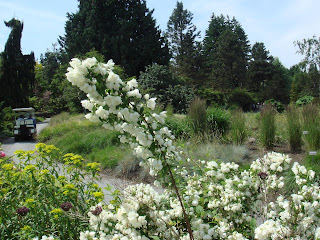 On June 26, I spent a nice afternoon with my friend at VanDusen Botanical Garden. This beautiful garden is located on Oak Street and 37th Avenue in Vancouver. It’s not free though, good that I had a coupon of second complimentary admission … instead of paying $10.25 each, we paid $10.25 for two :)
On June 26, I spent a nice afternoon with my friend at VanDusen Botanical Garden. This beautiful garden is located on Oak Street and 37th Avenue in Vancouver. It’s not free though, good that I had a coupon of second complimentary admission … instead of paying $10.25 each, we paid $10.25 for two :)
VanDusen Botanical Garden was opened to the public in August of 1975. It is a 55-acre (22 hectare) garden with 7500 kinds of plants from around the world! Some plants have been saved from extinction since the garden provides a safe place for them to grow. Unlike parks and display gardens, botanical gardens are living museums and their plant collections are scientifically organized, documented and labelled.


 Since it was my first time visiting VanDusen, there were some interesting places that I have missed such as Medicine Wheel, Elizabethan Maze, Mediterranean Garden and Cypress Pond. I began my route with Phyllis Bentall Garden (the top photo with pink water lilies in the pond was from this garden) -> Ornamental Grasses -> Livingstone Lake -> Southern Hemisphere -> Heather Garden -> Heron Lake (or maybe Heather Pond?) -> Sino-Himalayan -> Waterfall -> Meditation Garden -> Korean Pavilion -> Canadian Heritage Garden -> Camellia Collection -> Witchhazels ->Hydrangeas -> Lathhouse -> Laburnum Walk -> Rose Garden.
Since it was my first time visiting VanDusen, there were some interesting places that I have missed such as Medicine Wheel, Elizabethan Maze, Mediterranean Garden and Cypress Pond. I began my route with Phyllis Bentall Garden (the top photo with pink water lilies in the pond was from this garden) -> Ornamental Grasses -> Livingstone Lake -> Southern Hemisphere -> Heather Garden -> Heron Lake (or maybe Heather Pond?) -> Sino-Himalayan -> Waterfall -> Meditation Garden -> Korean Pavilion -> Canadian Heritage Garden -> Camellia Collection -> Witchhazels ->Hydrangeas -> Lathhouse -> Laburnum Walk -> Rose Garden.  Mock Orange - Hydrangea family, native to North America
Mock Orange - Hydrangea family, native to North America
 Ornamental Onion - onion family, native from Turkey to Hungary and Yugoslavia
Ornamental Onion - onion family, native from Turkey to Hungary and Yugoslavia


 Southern Hemisphere Garden - where the plants grown in southern hemisphere can be found such as Monkey Puzzle Tree from Argentina, Brazil and Chile or Eucalyptus from Australia.
Southern Hemisphere Garden - where the plants grown in southern hemisphere can be found such as Monkey Puzzle Tree from Argentina, Brazil and Chile or Eucalyptus from Australia.
 I believe this water lily is called "Nymphaea" or in Chinese 耐寒的睡蓮
I believe this water lily is called "Nymphaea" or in Chinese 耐寒的睡蓮

 I could view the beautiful blue sky and the mountain from North Vancouver in the open area of Vandusen Garden!
I could view the beautiful blue sky and the mountain from North Vancouver in the open area of Vandusen Garden!


Himalayan blue poppies in Sino-Himalayan Garden

Korean Pavilion - this hexagonal pavilion was a gift from the people of Korea at the end of 1986 World Expo in Vancouver. It is surrounded by Korean native plants such as its national flower, Hibiscus Syriacus (Rose of Sharon).


Canadian Heritage Garden

 Chinese Witch Hazel (Hubei and Jiangxi Provinces)
Chinese Witch Hazel (Hubei and Jiangxi Provinces)
























No comments:
Post a Comment